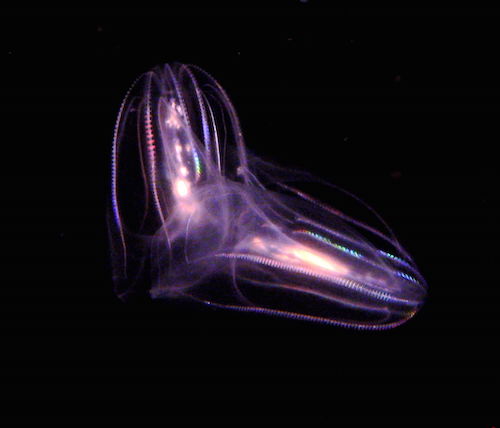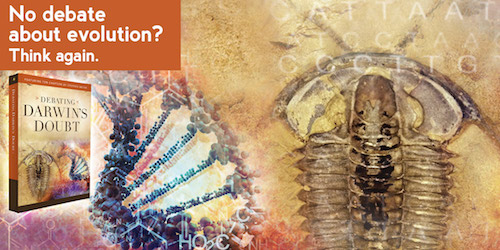 Evolution
Evolution
 Intelligent Design
Intelligent Design
Earliest Comb Jellies Wore Armor

What does it take to wear armor? An animal has to be able to make the material and put it where it belongs. To be functional, the armor cannot interfere with the animal’s movement. And the animal cannot simply glue sand particles on its exterior in a haphazard way. The appropriate materials, directed by genetic instructions, must be manufactured and placed holistically so that the finished armor provides a beneficial function. It would be surprising, under an evolutionary view, to find such a complex system in the earliest animal fossils. But that’s what Chinese paleontologists discovered in their country’s early Cambrian rocks.
Phylum Ctenophora (cilia-bearing) has about 150 living representatives. While most of them have tentacles, none have hard parts. Varying in size from a few millimeters to over a meter, they resemble jellyfish (phylum Cnidaria) in being gelatinous and transparent, but are distinct in having eight-fold radial symmetry with comb-like rows of fused cilia that propel them around. Some living comb jellies give stunning light shows as their comb rows reflect light in rainbows of iridescent colors, making them resemble alien spacecraft (watch on YouTube). Though not bilaterians, they have complex body plans with a buoyancy organ called a statolith, muscles, a nervous system, an alimentary canal, and the ability to control the direction of their locomotion. The phylum made its appearance in the earliest Cambrian layers, dated 520 million years ago. That takes us to the Chengjiang biota in China, one of the finest exposures of early Cambrian fossils in the world.
Seven Chinese researchers found beautifully preserved comb jellies in lower Cambrian strata — three new species and three reclassified species — all with armor. Their open-access paper in Science Advances, “A vanished history of skeletonization in Cambrian comb jellies,” shows the photographs of the fossils along with diagrams of how they probably looked. Armored struts and plates are arranged in complex shapes along the animals’ exterior, following the eight-fold symmetry and making up complex curves. One of the species has spines along its outer struts. The fossil hunters were quite surprised:
They share a basic body plan characterized by a tentacleless and octaradial body with an oral-aboral axis, eight rigid struts (termed here “spokes”) radiating from the aboral end and arched to converge to the oral end, eight soft-bodied flaps or lobes supported by the spokes, eight pairs of ctene rows, a conspicuous apical (or aboral) organ walled by eight rigid plates and housing a spheroidal or ellipsoidal statolith, and an oral region surrounded by eight apiculate lappets…
The eight arcuate spokes [in one species] bear robust spines (Fig. 2, L to N, and figs. S4 to S6) and retain their structural integrity even when disarticulated, suggesting a remarkable degree of sclerotization. [Emphasis added.]
The plates have “considerable rigidity,” they noticed, retaining their integrity even when separated. Some of the hard parts protrude into different layers of sediments. It’s not clear what the armor is made of, but the authors presume it is chitin, the same protein that makes up the exoskeleton of arthropods. “The spokes and apical plates of scleroctenophores were likely cuticular or chitinous in composition, but the presence of minerals in their skeletons cannot be completely ruled out, given that the epidermis of extant ctenophores can produce Mg-Ca carbonates that partially form the statolith,” they say. The statoliths of some fossil specimens even preserve some organic carbon.
The authors are not sure about the function of the armor, but indulge in some evolutionary speculation. The typical evolutionary explanation is to imagine an “arms race” that forced the animals to defend themselves against a new class of predators. It seems obvious, though, that nothing about predation can cause a brainless animal to build a suit of armor. It could more easily just go extinct.
What’s even more remarkable (a word they use themselves) is that the ctenophores are not alone in being armored compared to living counterparts. They use this observation to support a view from the late Stephen Jay Gould that evolution is highly unpredictable:
The occurrence of sclerotized and armored skeletons in Cambrian representatives of several animal groups — including entoprocts, phoronids, lobopods, scalidophorans, and now ctenophores that are exclusively soft-bodied among modern survivors — is a remarkable phenomenon. The independent skeletonization among these diverse Cambrian animals provides indirect evidence for an intensified level of ecological interactions (for example, arms race) and also highlights the importance of paleontological data in illuminating the evolutionary legacy that would be otherwise inaccessible by studying living animals alone. The widespread occurrence of skeletonization echoes Stephen Jay Gould’s view of the striking morphological disparity of many animal phyla during their Cambrian debut, and the contrasting evolutionary trajectories of skeletonized cnidarians and ctenophores also elucidate the contingent fate of evolutionary innovations such as skeletonization.
This kind of explanation serves only to protect Darwinian evolution from the evidence. If animals are similar, they evolved. If animals are different, they evolved. But the authors noticed that the “morphological disparity” in the Cambrian explosion exists not only between phyla, but between species within phyla. Earlier, they referred to the explosion:
Here, we report several sclerotized and armored ctenophore species, based on new material and reinterpretation of previously published material from the early Cambrian Chengjiang biota (ca. 520 Ma). Along with armored Cambrian entoprocts, phoronids, lobopods, and scalidophorans, the new fossils suggest a vanished Cambrian history of skeletonization in multiple animal groups, imply the ecological importance of skeletonization in the Cambrian explosion, and highlight the remarkable morphological disparity in certain Cambrian animal clades relative to their modern survivors.
A “vanished Cambrian history of skeletonization in multiple animal groups” is inconsistent with Darwinian evolution. “Ecological importance” is incapable of producing genetic programming for an armored skeleton. “Morphological disparity” at the earliest onset of complex animals is the opposite of Darwin’s image of a branching tree gradually separating into more and more complex types.
Designers, by contrast, know how to apply a common solution in different applications. That’s why it’s unsurprising to see complex armor in disparate groups from the beginning.
Stephen Meyer did not go into detail about ctenophores in Darwin’s Doubt, other than to note they are among the phyla that suddenly appeared in the Cambrian explosion (p. 32). But this new revelation that ctenophores are more complex than originally realized, possessing elaborate armor, certainly reinforces his contention that “the best explanation for the explosion of information necessary for the Cambrian animals… remains intelligent design” (see the Epilogue in the paperback edition, p. 448).
Join the debate! Order Debating Darwin’s Doubt, edited by David Klinghoffer, with a limited-time discount of 35 percent off the cover price (enter the discount code 4DXTSYJU) to read this new collection of responses to critics of Meyer’s original book, including ten chapters by Stephen Meyer.
Image: Two modern comb jellies, by Steve Jurvetson from Menlo Park, USA (What’s That? (62)) [CC BY 2.0], via Wikimedia Commons.

